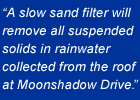
| Home |
| Introduction |
| Hypothesis |
| Methodology |
| |
| |
| Data & Analysis |
| Conclusion |
| Credits |
| Learn More |

 Hardness testing |
 Suspended solids testing |
 Coliform testing |
Test Procedures
A rough procedural overview for tests performed at the EWEB Hayden Bridge Water Treatment Facility is listed below. EWEB follows the Standard Methods for Analysis of Supply and Waste Water. For exact testing procedures, consult the EPA publication of the same name.
pH - The measure of the water's relative acidity or alkalinity. A pH of 7 is neutral while higher numbers indicate acidity and lower alkalinity (MEEB, p. 574-575).
- 50 ml sample
- rinse buffer off probe
- insert in sample and rotate
- read meter
Conductivity - A measure of how well the water conducts electricity. This gives an indication of ion concentration in the water sample.
- 50 ml sample
- rinse probe with de-ionization solution
- insert in sample and rotate
- read meter
Turbidity - Measures the impedance of light through water. The particles which cause turbidity can interfere with disinfection by sheltering microbes. (SDWA, 1974)
- 27 ml sample placed in vial
- carefully wipe with a no-lint, silicon & oil impregnated cloth
- insert in machine
- read meter
Hardness - inhibits the cleaning action of soaps and detergents. It can also cause deposits of scale on the inside of hot water pipes and cooking utensils. Hardness is caused by calcium and high levels of magnesium salts (MEEB, p. 574).
- 100 ml sample
- add 10 drops ammonium hydroxide
- add 2 drops indicator (phenol.)
- titrate with EDTA (ethylene diamine tetra-acetic acid) until color changes
Coliform Colony Count - Indicator organisms (such as Escherichis coli) are used as a proxy for the presence of specific disease-causing organisms like Salmonella typhi.
- 100 ml sample
- pour through 0.45 micron filter
- place filter in petri dish with pad holding m-endo broth
- incubate for 24 hours before counting colonies
Total Suspended Solids (TSS) - are undissolved particles ranging in size from a pine needle to a single-cell bacterial organism.
- 100 ml sample
- glass micron filter dried 1.5 hours prior to test
- pour sample through filter
- dry filter for 1.5 hours and check difference in weight
Rainwater Harvesting is a Vital Signs Case Study
prepared by Angela Matt and
Joshua Cohen, Spring 2001.